How Boomerang Grew to $8 Million ARR Through Systematic Experimentation: Aye Moah's Bootstrap Playbook
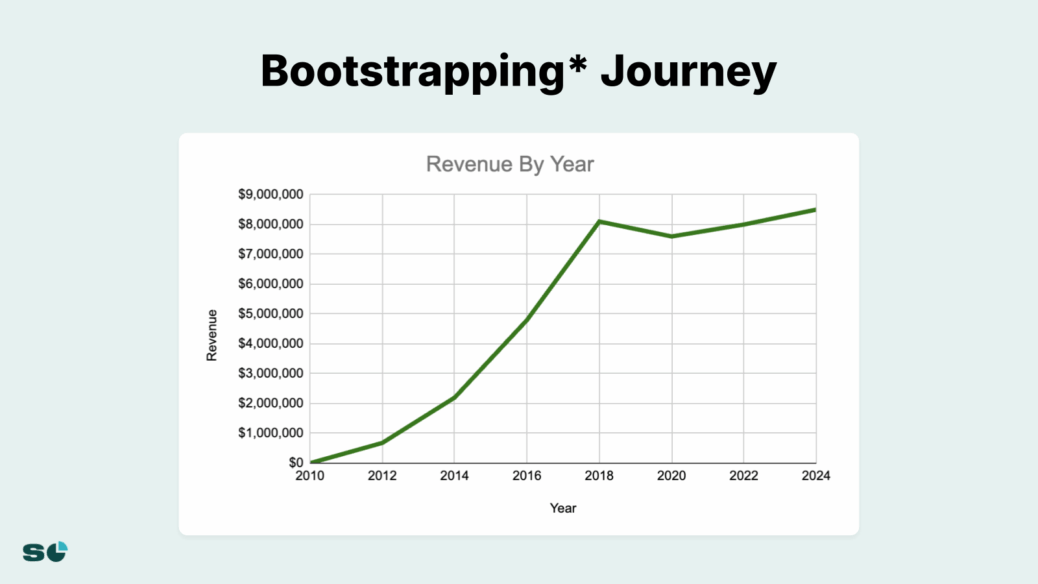
This article was written and sourced from Aye Moah’s keynote presentation at Founderpath’s last event. The images embedded below are from their slide deck. The full keynote recording is here.
Aye Moah transformed Boomerang from three engineers with maxed-out credit cards into an $8 million ARR email productivity powerhouse by executing 44 growth experiments in just eight months. Speaking at SaaSOpen in September 2024, Moah revealed how his team added $500,000 in incremental revenue through systematic testing while maintaining a lean 19-person team and issuing regular dividends to shareholders.
The Playbook: 5 Lessons from Boomerang’s Journey to $8 Million ARR
1. Run One Experiment Per Week: Boomerang executed 44 experiments in 8 months, generating $500K in additional ARR (6% of total revenue). The key isn’t perfection—it’s velocity and learning from both wins and failures.
2. Big Red Buttons Beat Complex Features: Simple changes like switching from blue links to red buttons generated more revenue than months of complex product development. Their trial-ending email optimization alone added $250K in ARR.
3. Stay Radically Lean: With just 19 employees generating $8 million ARR, Boomerang proves the Mythical Man-Month principle—adding more people doesn’t mean building faster. They’ve had only one voluntary departure in five years.
4. When Experiments Fail, Go Opposite: After their meeting confirmation page redesigns failed, they tried the radical opposite approach—removing all marketing elements. Result: 14% conversion improvement through minimalism.
5. Dividends Over Dilution: By staying profitable since 2012, Boomerang has issued regular dividends providing 4-5x returns to investors while funding 10 schools in Burma and maintaining founder control.
2010: Three Engineers Launch Email’s First Snooze Button with $400K and Credit Card Debt
Boomerang’s origin story begins with three first-time founders who were so cash-strapped they were putting moving expenses on credit cards when relocating to California. As the inventors of the email snooze button—now ubiquitous in Gmail, Outlook, and Superhuman—they pioneered the email productivity category before virality and PLG (product-led growth) even had names.
The founding team raised just $400,000 in their initial round, which had to support three founders, one employee, and one contractor for 18 months. This extreme capital efficiency forced them to adopt principles that would define their growth strategy for the next 14 years.
Moah emphasizes a critical metric most founders overlook: “We have turned every single dollar of investment into about $125 in revenue to date.” This 125x revenue-to-investment ratio demonstrates the power of bootstrapped growth when combined with systematic experimentation.
2012: Boomerang Achieves Profitability and Never Raises Again
Within 18 months of launch, Boomerang reached profitability and made a decision that would shape their entire trajectory: they would never raise venture capital again. While their peers in 2012 were raising massive rounds and prioritizing growth at all costs, Boomerang chose a different path.
“It wasn’t popular or cool back then,” Moah recalls. The team developed a culture of consistently exceeding their own revenue projections while maintaining what he calls a “fanatical focus on keeping everything lean and simple.” This approach allowed them to maintain control while their competitors burned through capital chasing unsustainable growth metrics.
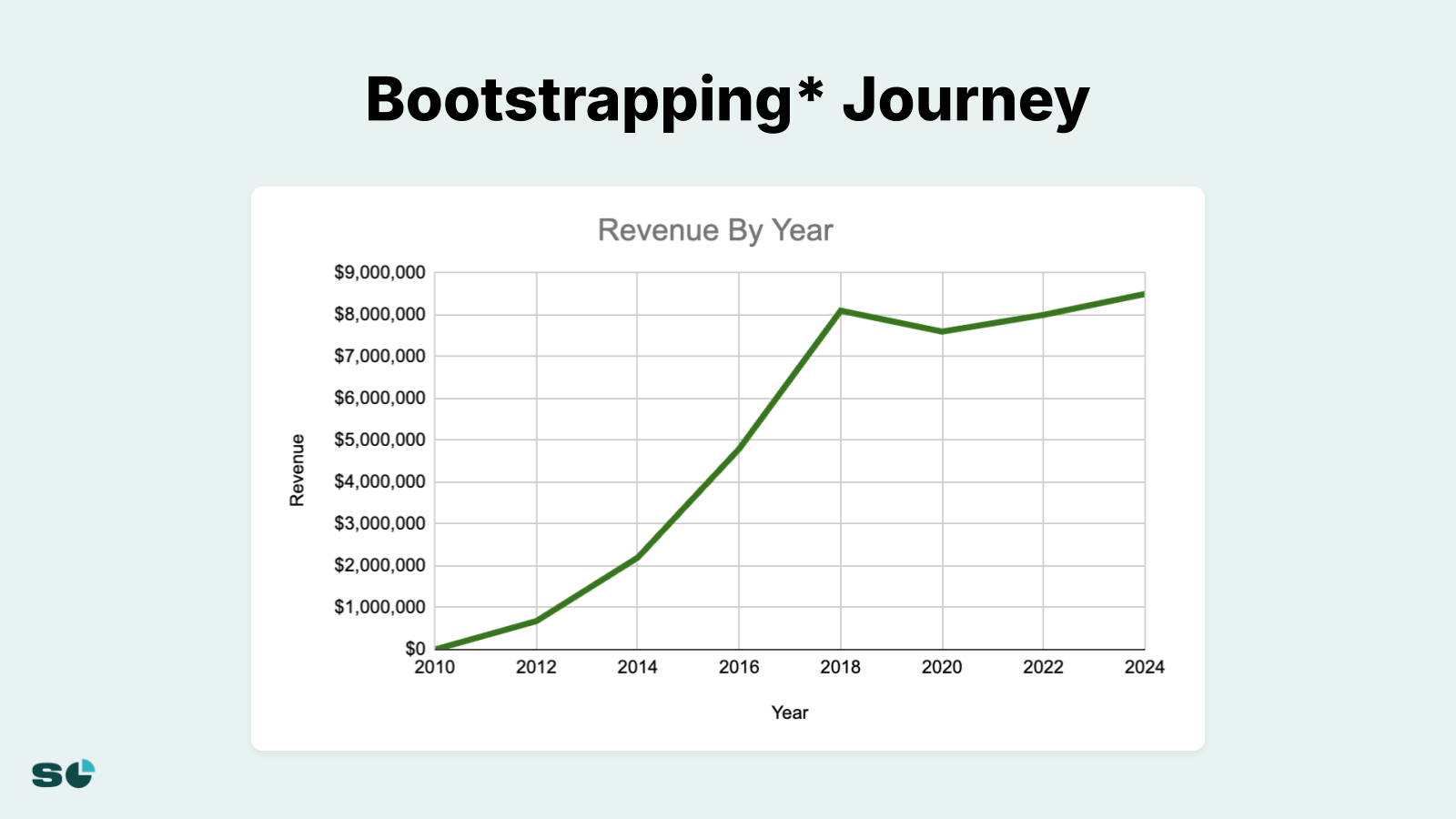
2024: The Year of Experiments Generates $500K in 8 Months
At the beginning of 2024, with the company already at approximately $7.5 million ARR, Moah declared it “The Year of Experiments.” The results speak for themselves:
- 44 experiments executed year-to-date
- 19 successful experiments integrated into the product
- 10 failures that provided valuable learning
- 15 experiments still in flight
- $500,000 in incremental ARR (6% revenue increase)
The experiments ranged from marketing optimizations to product improvements, virality enhancements, and building practice changes. What’s remarkable is the speed of execution—from announcing the initiative to launching the first experiment took just two weeks, with a core experiment team of only five people.
Trial Ending Emails: How Three Red Buttons Generated $250K ARR
Boomerang’s highest-impact experiment focused on optimizing trial-ending emails for their freemium SaaS model. As Moah explains, many trial users convert to free basic users rather than paid subscriptions, creating a massive opportunity for optimization that they had previously neglected.
The solution was embarrassingly simple: changing blue text links to red buttons. Through four iterative experiments, they achieved:
- $250,000 in new subscriber revenue from free-to-paid conversions
- Significant improvement in trial-to-paid conversion rates
- Team jokes about renaming 2024 to “The Year of Big Red Buttons”
Moah’s advice to founders and marketing teams is direct: “Go back and ask them, have you tried a red button?” The lesson here isn’t just about button colors—it’s about testing obvious changes that teams often overlook while chasing complex solutions. Access Moah’s complete presentation to see the exact email templates that drove these results.
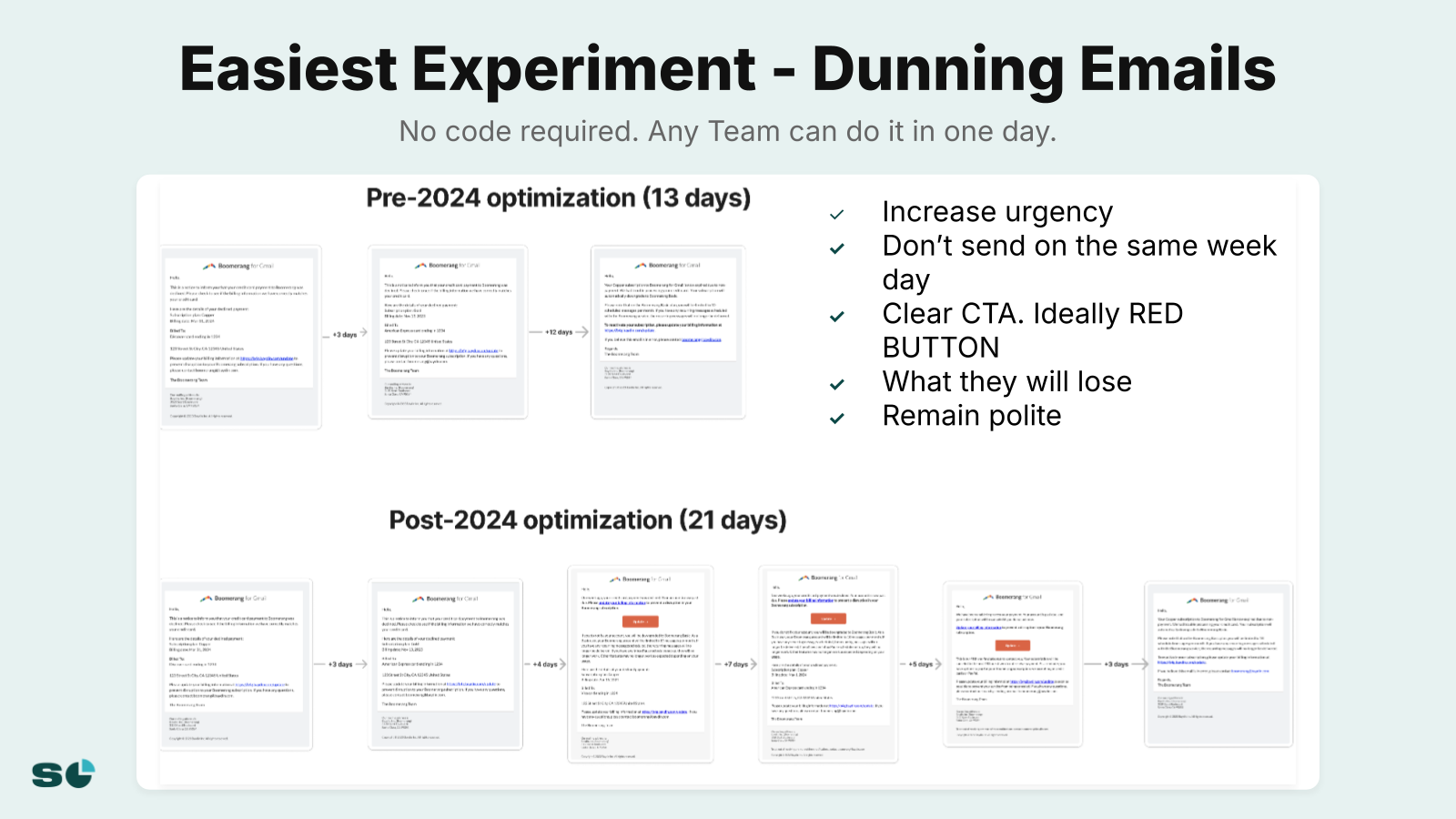
Dunning Sequence Magic: 12% Recovery Rate Improvement in One Day
The easiest high-impact experiment Boomerang ran required zero code and could be implemented by any marketing team in a single day: optimizing dunning emails. For those unfamiliar, dunning emails are sent when recurring subscription payments fail due to expired cards or technical issues—representing involuntary churn from customers who actually want to keep using the product.
Boomerang’s dunning email optimization strategy included five key principles:
- Increase urgency progressively across the email sequence
- Vary sending weekdays (never send reminders exactly 7 days apart due to banking quirks)
- Clear CTA with red buttons (they added three red buttons per email)
- Emphasize what users will lose rather than what they’ll gain
- Remain polite and professional (avoid desperate car-salesman tactics)
The results were immediate and substantial: recovery rates improved by 12%, moving Boomerang from the 29th percentile to the 52nd percentile in their industry according to Baremetrics benchmarks. As Moah points out, “These subscribers already use and love your product—don’t you want to retain 12% more every single month?”
Meeting Confirmation Virality: When Less Marketing Delivers 14% More Conversions
Boomerang’s meeting scheduling feature presented a unique virality opportunity. Every time a Boomerang user sends a meeting invitation, recipients see a live calendar image that updates in real-time across all email clients. When recipients click through, they land on a confirmation page—a high-leverage touchpoint for user acquisition.
The initial hypothesis seemed logical: add more value propositions and marketing messages to convert these meeting guests into users. The design team created variants with enhanced branding, bright call-to-action buttons, and detailed feature explanations. Both variants lost to the control.
Instead of abandoning the experiment, the team went in the completely opposite direction:
- Removed all bright color buttons
- Eliminated marketing information
- Reduced branding to subtle elements
- Kept only the simple tagline: “Schedule meetings with Boomerang”
This minimalist approach increased conversions from 1% to approximately 14% across their user base. Moah’s lesson: “When something doesn’t go the way you expect, try the completely radical opposite direction.”
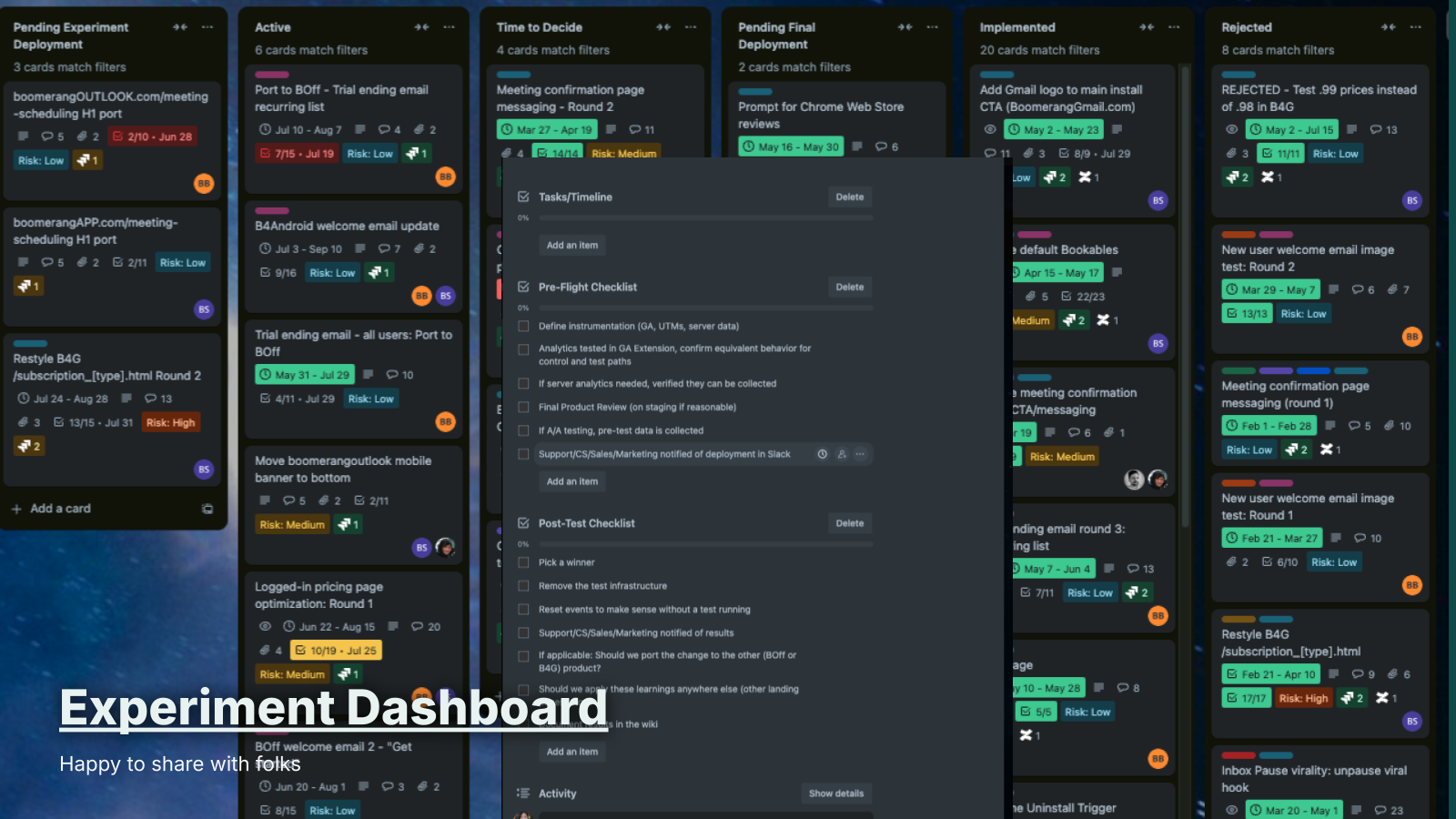
The RICE Framework Reimagined: Why Confidence Doesn’t Matter in Experimentation
Boomerang modified the traditional RICE (Risk, Impact, Confidence, Effort) prioritization framework with a crucial insight: confidence is meaningless in true experimentation. “If we’re so sure this is going to work, you just do it. The whole point of experiments is you don’t know what will work.”
They replaced Confidence with Complexity, creating a more practical framework:
- Risk: Potential negative impact on existing revenue/users
- Impact: The potential upside (this “beats everything else”)
- Complexity: How difficult the experiment is to run cleanly (different from effort)
- Effort: Resources required to execute
This framework helped them identify a critical distinction: some high-effort experiments are simple to run with clean cohorts, while some low-effort changes have complex measurement challenges. Their experiment dashboard, which Moah offers to share with other founders, went through 4-5 iterations to capture learnings from every mistake.
19 Employees, $8 Million ARR: The Mythical Man-Month in Practice
Perhaps the most striking aspect of Boomerang’s story is their team size: just 19 people generating $8 million in ARR. This represents approximately $421,000 in revenue per employee—a metric that would make even the most efficient SaaS companies envious.
Moah credits this efficiency to embracing the principles from “The Mythical Man-Month,” the classic engineering text that demonstrates how adding more people often slows down development due to communication overhead. Boomerang operates on what he calls an “elite squad model”:
- Very high performance expectations
- Excellent employee treatment and satisfaction
- Only one voluntary departure in the last five years
- Empowerment to question any initiative with “What’s the point of this?”
This last point is crucial to their culture. Every team member, from engineers to marketers, is empowered to challenge any request by asking “What’s the point of this?”—even directly to the CEO. This radical transparency ensures everyone understands not just what they’re doing, but why it matters to the business.
The Dividend Strategy: How Boomerang Delivered 4-5x Returns While Staying Independent
While most SaaS companies pursue traditional exit strategies through acquisition or IPO, Boomerang chose a fourth path: dividends. As Moah explains, acquisitions, IPOs, and secondaries all require transferring ownership, but dividends allow founders to get paid while maintaining complete control.
The impact of this strategy extends far beyond the founding team:
- Investors have received 4-5x returns on their initial investment
- All shareholders, including employees, receive regular dividend payments
- The company has funded 10 schools in Burma (Myanmar)
- They’ve supported 6 climate tech research projects
- The team celebrates success with experiences like dinners at The French Laundry
- They maintain an annual “hackathon week” for innovation
- The company has generated 11 patents
This approach validates what Moah calls “owning your destiny”—the ability to build a company at your own pace while generating meaningful returns for all stakeholders.
Lessons from 44 Experiments: Why Velocity Beats Perfection
After running 44 experiments in eight months, Boomerang discovered several counterintuitive truths about growth optimization:
Second-Order Effects Can Kill Winners: One experiment added a download button to a high-traffic tutorial page, initially driving conversions. However, Google began penalizing the page for having a conversion button, ultimately eliminating all organic SEO traffic. The lesson: always consider ripple effects beyond immediate metrics.
Big Swings Don’t Equal Big Wins: Their most ambitious experiment—a major funnel redesign that took 2.5 months to build—generated less revenue than simply changing button colors. Simple optimizations often outperform complex product overhauls.
No Peeking Rules: The temptation to check experiment results early is universal, but acting on incomplete data undermines the entire process. Even Moah admits his team struggles with this discipline.
Templates and Checklists Scale Learning: By documenting every experiment in templates and creating checklists from mistakes, Boomerang ensures institutional knowledge compounds over time rather than being lost.
The Bottom Line: Boomerang Proves Bootstrap Growth Can Compete with Venture Scale
Aye Moah’s journey with Boomerang challenges every assumption about SaaS growth. By turning $400,000 in initial investment into $8 million in ARR—a 125x revenue-to-investment ratio—while maintaining profitability since 2012, Boomerang demonstrates that systematic experimentation and radical efficiency can compete with venture-funded growth.
The company’s 2024 experiment initiative proves that even mature SaaS businesses can find significant growth through disciplined testing. With $500,000 in incremental revenue from 44 experiments, Boomerang shows that innovation doesn’t require massive teams or budgets—it requires velocity, humility, and a willingness to challenge assumptions.
For founders evaluating their growth strategy, Moah’s closing message resonates: “There is a path where you can build things that you love at a pace that you’re comfortable with. There are people telling you that’s not possible. Try to keep that in mind.”
With their combination of systematic experimentation, extreme capital efficiency, and commitment to stakeholder value through dividends, Boomerang has created a playbook for sustainable SaaS growth that delivers both financial returns and social impact—funding schools in Burma while maintaining complete founder control.
To learn more growth strategies from successful SaaS founders, explore webinars and resources that can help accelerate your company’s experimentation velocity.
If you’re an ambitious founder looking for capital to grow, we’d love to consider funding you at Founderpath. Click here to request capital.
Recent Articles
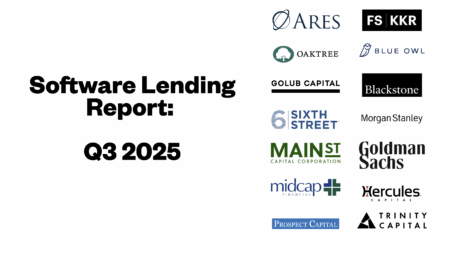
Software Debt Q3 2025 Benchmarks
As of Q3 2025, the country’s largest publicly traded direct lenders collectively hold $23.4 billion of software-related loans on their…
Top Growth Frameworks for Founders in 2025
The Ultimate Guide to Startup Growth Frameworks (With Real Founder Examples) Most founders think about growth in terms of tactics:…
Founderpath Frequently Asked Questions
What types of funding products does Founderpath offer? We currently offer two main products for B2B SaaS founders: Revenue-based financing:…